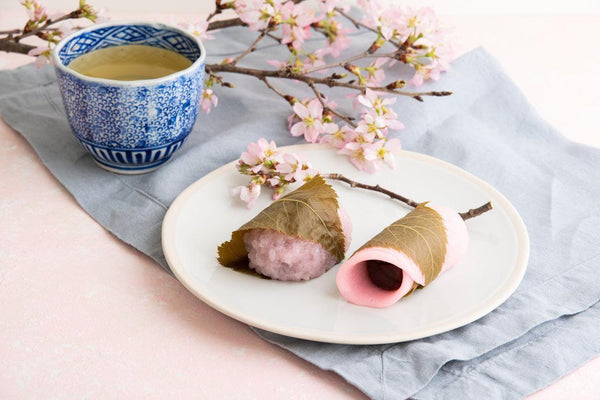
Jump to:
The beginning of spring is marked by the blossoming of the sakura cherry blossoms in Japan. Many people love participating in hanami, or cherry blossom viewing, and what better way to ring in spring than with a yummy treat like sakura mochi to pair with the beautiful cherry blossom buds?
If you’re unfamiliar with sakura mochi, we will cover everything you need to know about the tasty sakura-themed Japanese wagashi. Stay tuned to learn more about this cute and sweet traditional treat.
What is Sakura Mochi?

Sakura mochi is a type of wagashi or traditional Japanese sweet that features the faint flavor of cherry blossoms. A pink-colored rice cake is filled with red bean paste (anko) and is wrapped in a pickled cherry blossom leaf. They make a lovely snack to enjoy during hanami or hina matsuri (girl’s day) in Japan.
Typically, koshi-an (smooth red bean paste) is used as the filling for sakura mochi instead of tsubu-an (chunky red bean paste). Due to the addition of pickled sakura leaves in this wagashi, sakura mochi also have a soft cherry blossom scent and slightly-salty flavor.
During spring, grocery stores, specialty wagashi shops, and even convenience stores around Japan sell sakura mochi so that everyone can enjoy them. It is a seasonal Japanese sweet that truly represents the arrival of spring.
Are There Different Types Of Sakura Mochi?
There are two different kinds of sakura mochi available in Japan and they are divided by region. These two styles are called the Kanto style and Kansai style. While both styles of sakura mochi share the same name, their differences are big enough to tell them apart easily.
Kanto-Style

The Kanto-style of sakura mochi has a rolled pancake-like appearance. This is due to the use of a glutinous rice flour called shiratamako (白玉粉) which is used to make the mochi dough. This kind of glutinous rice flour is common for making another kind of Japanese wagashi called dango. It gives wagashi a chewy and bouncy texture.
The mochi dough for Kanto-style sakura mochi is cooked in a frying pan, which gives it a texture similar to that of a crepe. Smooth red bean paste is added to the center of the sakura mochi, and it is finished by being wrapped in a pickled sakura leaf. Usually, Kanto-style sakura mochi is folded in half, but you can also find this wagashi being sold in a tubular shape.
Kanto-style sakura mochi is enjoyed in the entirety of the Kanto region, so Tokyo and surrounding areas like Kanagawa and Chiba prefectures. It is also enjoyed in other areas of Japan like Fukushima and Nagano prefectures, which were heavily influenced during the Edo period.
Kansai-Style

The Kansai-style of sakura mochi, also referred to as Domyoji-mochi, is mainly enjoyed in Japan's western or Kansai region. Many people believe that this variation of sakura mochi originates from the Domyoji temple in Osaka, but that is actually not the case. It is often referred to as Domyoji-mochi because it is made with domyoji flour. Domyoji flour is a glutinous rice flour that consists of textured rice grains. It actually resembles glutinous rice more than rice flour. The use of domyoji flour gives Kansai sakura mochi more texture, as the glutinous rice is stickier and the shape of the rice grains is still pronounced.
For making Kansai-style sakura mochi, domyoji flour is soaked and steamed, rolled into a round shape, filled with smooth red bean paste, and wrapped in a pickled sakura leaf. Since domyoji flour is made of textured glutinous rice, Kansai-style sakura mochi has quite a chewy texture. Depending on the type and the brand of domyoji flour, the texture of Kansai-style sakura mochi can differ on the producer and region.
While Kansai-style sakura mochi is enjoyed throughout the Kansai region of Japan like in cities such as Osaka and Kyoto, it is also enjoyed in other regions ranging from Hokkaido to Okinawa. It is believed that even though the Kansai-style of sakura mochi is based off of its counterpart or the Kanto style, it is probably the version that is more widely recognized in Japan.
Making Sakura Mochi at home
Sakura mochi can easily be at home, but a few special ingredients are necessary. Depending on which style you want to make, you will need either shiratamako or domyoji glutinous rice flour. You will also need pickled sakura leaves. These ingredients may be hard to find in your local grocery store, but you can definitely purchase them online.
In the case of Japanese Taste, we sell Shiratamako flour made of 100% authentic Japanese rice that can be used for making sakura mochi and other kinds of Japanese wagashi. We also have a recipe for both Kanto-style and Kansai-style sakura mochi, so be sure to check them out!
Origin And History

As there are two versions of sakura mochi that exist in Japan, there are also two sets of history associated with these sweets. However, the Kanto-style of sakura mochi is said to be the original version.
Sakura mochi was invented in 1717 during the Edo period by Shinroku Yamamoto who was the gatekeeper of the Chomeiji temple. He would take leaves that fell from sakura trees along the Sumida river in Tokyo and ferment them in soy sauce barrels, later wrapping them around mochi rice cakes and selling them to the public. During this time, sakura mochi was also known as Chomeiji mochi. The theory as to why Yamamoto created sakura mochi was so that people could enjoy them as a treat while visiting their relatives’ graves. It was also a good way to use the fallen sakura leaves.
Kansai-style sakura mochi, on the other hand, was invented in the early 1800s. It is thought that the Kansai-style was created after the Chomeiji, or Kanto-style of sakura mochi became popularized in the Edo period. In order to create something unique to the Kansai region, it was decided to use Domyoji rice flour.
When is Sakura Mochi Usually Enjoyed?

Sakura mochi is a seasonal Japanese wagashi that represents the coming of spring. Thus, it is enjoyed during the spring months, especially when the sakura trees are in bloom. Japanese people take the opportunity to celebrate the sprouting of the cherry blossoms by having picnics under the trees and eating sakura mochi.
Another popular time when sakura mochi is enjoyed is during Hina Matsuri, known as Girl’s Day or Doll’s Day, which takes place on March 3rd every year. Every year on hina matsuri, families take the opportunity to pray for the health and wellness of their daughters by displaying hina dolls in their homes. Families also get together and eat an array of delicious foods like chirashi sushi and sakura mochi.
Since sakura mochi is also available in supermarkets, convenience stores, and specialty wagashi shops in Japan during spring, many people feel comforted enjoying sakura mochi anytime during spring. No matter what occasion you decide to eat sakura mochi for, this sweet and sakura-scented Japanese dessert is guaranteed to bring you happiness.
How is it enjoyed?
Like other Japanese wagashi, sakura mochi is often paired with a cup of Japanese green tea. Japanese green teas such as matcha or sencha are popular choices for pairing with wagashi, but in the case of sakura mochi, it is said to pair especially well with genmaicha or hojicha. The sweetness of the rice cake and the floral aroma of cherry blossoms complement the natural bitterness of green tea.
Have you tried sakura mochi before? Which style do you prefer? Let us know in the comments below!


0 comments